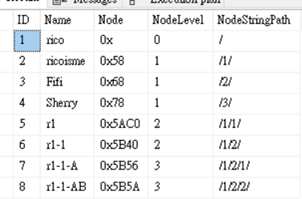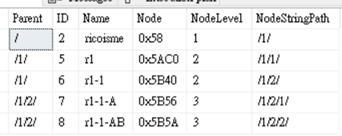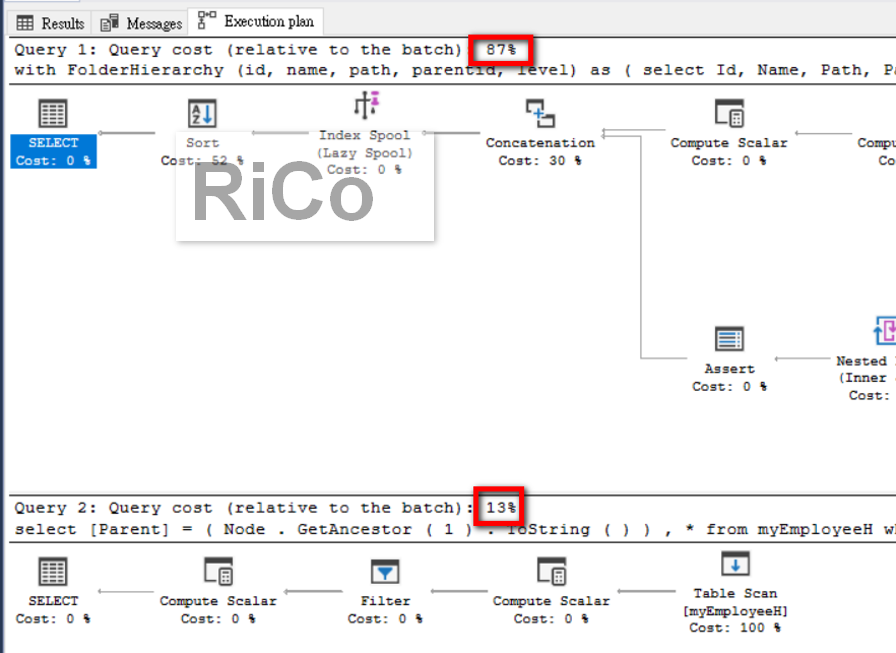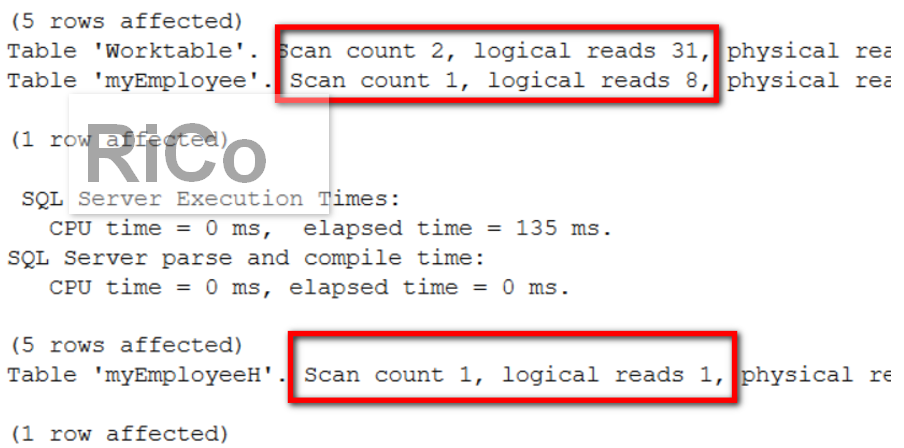樹狀(hierarchy)形結構資料,真實世界中很常見,SQL2005大多都使用CTE遞迴來達到目的,EF6開始也有支援該資料類型。
SQL2008推出hierarchyid資料類型,該類型長度是可變的,用來儲存階層結構資料,建立父子節點之間的關聯。
資料比較是按照深度優先,兩個hierarchyID(a和b),假設a<b,即先找a在找b,也就是說值越小越接近root node(/)。
CLR type為SqlHierarchyId,但該型別對應看來.net core 2.1有些限制
Support hierarchyid and user defined types #365
Scaffolding literals for SqlHierarchyId (and possibly other UDTs) doesn't work
目前SqlHierarchyid只能在.NET Framework執行,.NET Core不能執行,
這真叫人傷心,因為hierarchyid查詢樹狀資料效能,會比CTE遞迴來的好,
但資料更新方面需額外注意,下面我簡單示範
Hierarchyid需”/”開頭”/”結尾,中間使用數字標示一個元素,如/1/2/3/
declare @myhiera HierarchyID
declare @myhierb HierarchyID
declare @myhierc HierarchyID
set @myhiera='/11/21/31/'
set @myhierb=HierarchyID::Parse('/11/21/31/')
set @myhierc=@myhiera
select @myhiera as c1,@myhierb.ToString() as c2,@myhierc.ToString() as c3

我個人常用方法
create table myEmployeeH (
ID INT UNIQUE NOT NULL,
Name VARCHAR(50) NOT NULL,
Node HierarchyID ,
NodeLevel as Node.GetLevel(), -- GetLevel 節點深度
NodeStringPath as (Node.ToString())
)
create unique index UIX_NodeLevel on myEmployeeH (NodeLevel,Node)
go
GetRoot():靜態方法,回傳樹狀結構的root
insert into myEmployeeH (ID,Name,Node)
values (1, 'rico',HierarchyId::GetRoot())
GetDescendant():傳回父系子節點
declare @parent hierarchyid = hierarchyid::GetRoot()
insert into myEmployeeH (ID,Name,Node)
values
(2,'ricoisme',@parent.GetDescendant(null,null))—參數表示左和右節點
Go
declare @parent hierarchyid = (select Node from myEmployeeH where name = 'rico')
declare @ricoisme hierarchyid = (select Node from myEmployeeH where name = 'ricoisme')
insert into myEmployeeH (ID,Name,Node) values (3, 'Fifi',@parent.GetDescendant(@ricoisme,null))
go
declare @parent hierarchyid = (select Node from myEmployeeH where name = 'rico')
declare @Fifi hierarchyid = (select Node from myEmployeeH where name = 'Fifi')
insert into myEmployeeH (ID,Name,Node) values(4, 'Sherry',@parent.GetDescendant(@Fifi,null))
go
declare @parent hierarchyid = (select Node from myEmployeeH where name = 'ricoisme')
insert into myEmployeeH (ID,Name,Node)
values
(5,'r1',@parent.GetDescendant(null,null))
go
declare @parent hierarchyid = (select Node from myEmployeeH where name = 'ricoisme')
declare @r1 hierarchyid = (select Node from myEmployeeH where name = 'r1')
insert into myEmployeeH (ID,Name,Node)
values
(6,'r1-1',@parent.GetDescendant(@r1,null))
go
declare @parent hierarchyid = (select Node from myEmployeeH where name = 'r1-1')
insert into myEmployeeH (ID,Name,Node)
values
(7,'r1-1-A',@parent.GetDescendant(null,null))
go
declare @parent hierarchyid = (select Node from myEmployeeH where name = 'r1-1')
declare @r11A hierarchyid = (select Node from myEmployeeH where name = 'r1-1-A')
insert into myEmployeeH (ID,Name,Node)
values
(8,'r1-1-AB',@parent.GetDescendant(@r11A,null))
Go
select * from myEmployeeH
 目前最大階層數=3
目前最大階層數=3
GetAncestor:代表this的第n階層
IsDescendantOf ( parent ):若為父系,return true
Parse:標準hierarchyID字串轉換成hierarchyID值,作用和ToString相反
--找出階層/1/的子樹狀資料
select [Parent]=(Node.GetAncestor(1).ToString())
,*
from myEmployeeH f1
where f1.Node.IsDescendantOf(HierarchyID::Parse('/1/')) = 1

--階層/1/2/的子樹狀資料

更新/1/2/節點成為/1/3/和相關子節點
--update parent
update myEmployeeH set node=HierarchyID::Parse('/1/3/')
where Node.GetAncestor(0).ToString()='/1/2/'
--update childs
update e set node=
HierarchyID::Parse( replace( left(Node.ToString(),5),'/1/2/','/1/3/')+ Right(Node.ToString(),len(Node.ToString())-5) )
--HierarchyID::Parse('/1/2/'+cast(e.id as varchar)+'/')
from myEmployeeH e
where Node.IsDescendantOf(HierarchyID::Parse('/1/2/'))=1
--check
select [Parent]=(Node.GetAncestor(1).ToString())
,*
from myEmployeeH f1
where f1.Node.IsDescendantOf(HierarchyID::Parse('/1/3/')) = 1

PS:delete parent node資料,預設不會連帶刪除childe nodes,需要自行處理
和CTE比較一下查詢樹狀結構資料效能
create table myEmployee (
ID INT UNIQUE NOT NULL,
Name VARCHAR(50) NOT NULL,
ParentId Int Null,
Path varchar(100)
)
create index IX_ParentId on myEmployee (ParentId)
go
insert into myEmployee values(1,'rico',null,'/')
,(2,'ricoisme',1,'/1/')
,(3,'Fifi',1,'/2/')
,(4,'Sherry',1,'/3/')
,(5,'r1',2,'/1/1/')
,(6,'r1-1',2,'/1/3/')
,(7,'r1-1-A',6,'/1/3/1/')
,(8,'r1-1-AB',6,'/1/3/2/')
set statistics io,time on
declare @Id int = 2;
with FolderHierarchy (id, name, path, parentid, level) as
(
select Id, Name, Path, ParentId, 1 as level from myEmployee where Id = @Id
union all
select f.Id, f.Name, f.Path, f.ParentId, level + 1 from myEmployee f
inner join FolderHierarchy h
on f.ParentId = h.Id
)
select * from FolderHierarchy order by level
select * from myEmployeeH
where Node.IsDescendantOf(HierarchyID::Parse('/1/'))=1

 擷取部分
擷取部分
參考
hierarchyid data type method reference